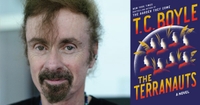DROP CITY
T. Coraghessan Boyle, Boyle T. C., . . Viking, $25.95 (464pp) ISBN 978-0-670-03172-6
Boyle has a wonderful eye for the comedy of imposture when the self-deceived themselves practice deception. His ninth novel, which centers on the travails of a hippie commune, Drop City, in the early '70s, gives him plenty of poseurs to work with. Drop City, in Sonoma County, Calif., is run, in a manner of speaking, by a gold-toothed purveyor of Aquarian notions, Norm Sender. The Drop City family includes Pan (aka Ronnie) and his high school pal Star (aka Paulette Regina Starr), who have fled from the East Coast together; two rather predatory black dudes; and a variegated crew of longhaired "cats" and flower-child "chicks." Star, sweet but often naïve, is the opposite of Pan, beneath whose free love patter lurks an unnerving rapacity. Star soon hooks up with Marco, whose solid virtues are concealed beneath his veil of hair. When "The Man," in the person of the Sonoma County sheriff's department, condemns the property, Norm, who has inherited other property far away in Boynton, Alaska, proposes a tribal migration north. Meanwhile, the news in Boynton is that local trapper Cecil "Sess" Harder is marrying Pamela McCoon, after an eccentric courtship ritual. Sess's major problem lately has been a violent feud with Joe Bosky, the local bush pilot. When the Drop City hippie bus rolls into Boynton, a comic clash of civilizations ensues. Building utopia upriver from the Harders, Drop City's denizens discover that polar climes demand rather drastic behavioral adaptations. Boyle understands the multitudinous, sneaky ways innocence insulates itself from ambiguity—but in this novel he leavens that cynical insight with genuine sweetness. While the Day-Glo of the hippie era has long since faded, this novel brings it all back home—and helps us see how much in the American grain it all really was.
Reviewed on: 01/06/2003
Genre: Fiction
Analog Audio Cassette - 978-1-4025-3631-1
Mass Market Paperbound - 544 pages - 978-0-14-200428-9
Open Ebook - 978-0-7865-7106-2
Open Ebook - 512 pages - 978-1-101-20035-3
Open Ebook - 978-1-101-41648-8
Open Ebook - 464 pages - 978-1-4088-2681-2
Paperback - 464 pages - 978-0-7475-7156-8
Peanut Press/Palm Reader - 978-0-7865-7107-9


